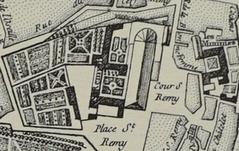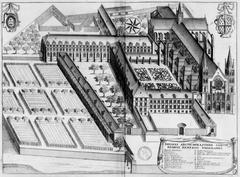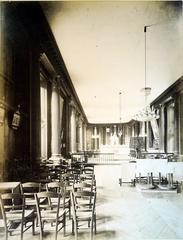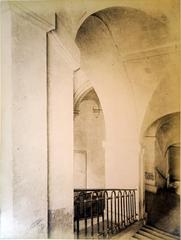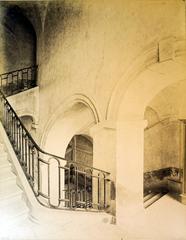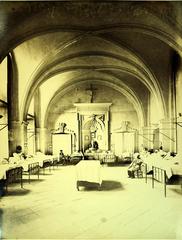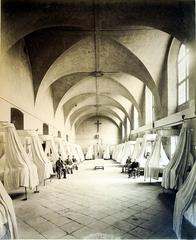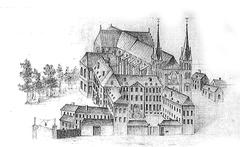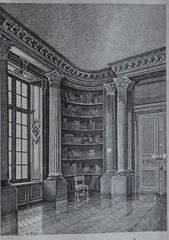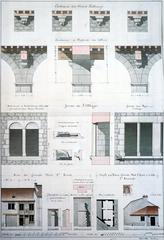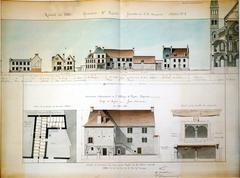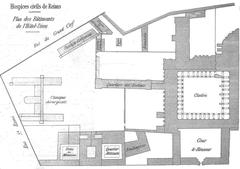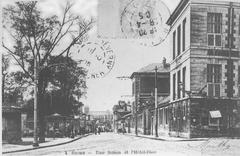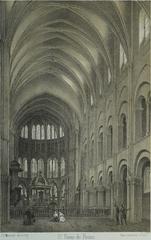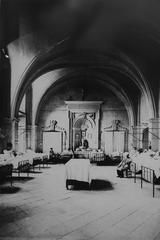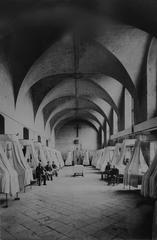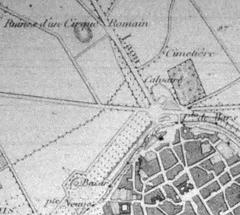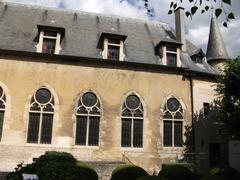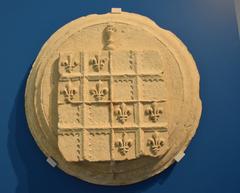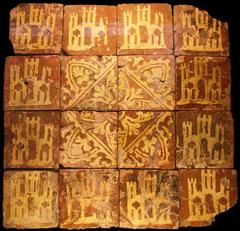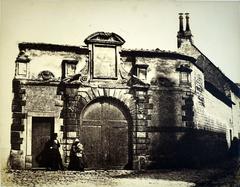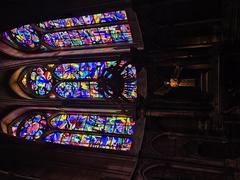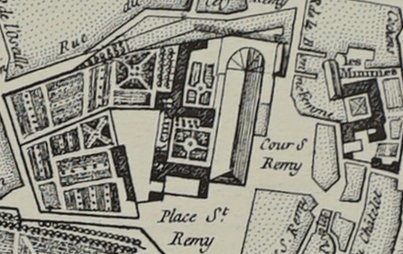
Abbey of Saint-Remi: Visiting Hours, Tickets, and History in Reims, France
Date: 14/06/2025
Introduction
Nestled in the historic city of Reims, the Abbey of Saint-Remi stands as a monumental testament to the religious, royal, and cultural heritage of France. Founded in the 6th century, this abbey is intrinsically tied to the Christianization of France and the coronation of its kings. Recognized as a UNESCO World Heritage Site alongside the Cathedral of Notre-Dame and the Palace of Tau, the Abbey of Saint-Remi offers visitors a unique opportunity to immerse themselves in centuries of history, architectural evolution, and vibrant cultural traditions. This comprehensive guide explores the abbey’s origins, its architectural and historical importance, practical visiting information, and tips for making the most of your time in Reims. For further details on visiting hours, tickets, and travel tips, refer to worldheritagesites.net and france-voyage.com.
Table of Contents
- Early Origins and Foundation
- Medieval Growth and Benedictine Reform
- Architectural Development
- Royal Connections and the Holy Ampoule
- Intellectual and Cultural Influence
- From Conflict to Heritage Site
- UNESCO World Heritage Status
- Visiting the Abbey: Practical Information
- Frequently Asked Questions (FAQ)
- Conclusion
- Additional Resources
Early Origins and Foundation
The Abbey of Saint-Remi’s roots stretch back to the 6th century. It is named after Saint Remigius (Saint Rémi), the bishop of Reims celebrated for baptizing Clovis, King of the Franks, in 496—a seminal event marking the Christianization of France and cementing Reims as the spiritual capital of the emerging nation (worldheritagesites.net). The original chapel was constructed over Saint Remigius’s tomb, quickly becoming a sacred pilgrimage site (encyclopedia.com).
Medieval Growth and Benedictine Reform
By the late 8th century, the abbey adopted the Benedictine rule under Archbishop Tilpin, aligning with broader Carolingian reforms. Royal and noble endowments enabled the abbey to gain considerable wealth and influence, with its monks holding prominent ecclesiastical positions and overseeing numerous priories (encyclopedia.com). Throughout the Middle Ages, the abbey flourished as a center of religious authority and learning.
Architectural Development
The Abbey of Saint-Remi’s basilica, constructed from 1005 to 1170, is the largest Romanesque structure in northern France, later enriched by Gothic additions (whc.unesco.org). Its vast nave and harmonious blend of Romanesque and Gothic styles reflect both the abbey’s spiritual significance and its status as a royal foundation.
Key Features:
- 126 meters long, 28 meters high
- Romanesque nave with rhythmic arches and columns
- Early Gothic choir and apse with ribbed vaults and large windows
- 12th-century stained glass windows, among the oldest in France
- Tomb of Saint Remi, a focal point for pilgrims
Royal Connections and the Holy Ampoule
The abbey’s most notable relic is the Holy Ampoule (Sainte Ampoule), believed to contain sacred oil used in the baptism of Clovis and the subsequent coronation of French kings (france-voyage.com). This vial, housed at Saint-Remi, became central to royal anointing ceremonies, reinforcing the divine legitimacy of France’s monarchs (whc.unesco.org).
Intellectual and Cultural Influence
Saint-Remi was renowned for its medieval library and scholars such as Flodoard and Remigius of Auxerre. Although a fire in 1774 destroyed many manuscripts, the abbey’s reputation as a center of learning and culture remains celebrated (encyclopedia.com).
From Conflict to Heritage Site
The abbey’s history also includes periods of tension, notably with the archbishops of Reims in the 13th century, prompting it to seek royal protection. It joined the Congregation of Saint Maur in 1627, emphasizing scholarship and discipline. The French Revolution led to the dissolution of the monastic community, but the basilica survived as a place of worship and heritage. Restoration after wartime damage, especially under architect Henri Deneux in the 20th century, set a benchmark for historic preservation.
UNESCO World Heritage Status
In 1991, the Abbey of Saint-Remi, along with the Cathedral of Notre-Dame and the Palace of Tau, was inscribed on the UNESCO World Heritage list in recognition of its architectural innovation and historical significance (whc.unesco.org).
Visiting the Abbey: Practical Information
Visiting Hours
- Basilica: Open daily from 9:30 AM to 6:00 PM (last entry at 5:30 PM).
- Closed: January 1, May 1, and December 25. Check for any additional closures or special event schedules on the official tourism site.
Tickets and Entry
- Basilica: Free admission for all visitors (Eupedia).
- Saint-Remi Museum: Open Tuesday to Sunday, typically 10:00 AM to 6:00 PM. Admission fees apply; discounts available for children, students, and with the Reims Epernay Pass (Reims Tourism).
Tours and Audio Guides
- Guided Tours: Available in French and English; book in advance, especially for groups. Guided tours for the basilica are free with the Reims Epernay Pass (Voyage Tips).
- Audio Guides: Available for rent on-site or via the Audiala app.
Accessibility
- Wheelchair Access: The basilica and museum are partially accessible, with ramps and adapted restrooms. Some historic areas, such as the cloisters, may be challenging.
- Restrooms: Available within the museum complex.
Facilities
- Cloakroom: Limited storage; large bags may not be permitted.
- Photography: Non-flash photography is allowed; tripods require prior permission.
Highlights and Events
- Luminiscence Show: A 50-minute immersive light and sound show in the basilica during summer evenings (Reims Tourism).
- Regular Mass and Concerts: Experience the basilica’s spiritual and acoustic ambiance.
Nearby Attractions
- Reims Cathedral (Notre-Dame de Reims) – UNESCO World Heritage Site, 10-minute walk
- Palace of Tau – Adjacent to the cathedral
- Musée des Beaux-Arts and Champagne houses
Travel Tips
- Best Times to Visit: Spring and early autumn for mild weather and fewer crowds.
- Getting There: 1.5–2 km from Gare de Reims; accessible on foot, by bus, taxi, or bicycle.
- Dining: Numerous cafés and restaurants within walking distance.
Frequently Asked Questions (FAQ)
Q: What are the Abbey of Saint-Remi’s visiting hours?
A: Open daily from 9:30 AM to 6:00 PM; last admission at 5:30 PM. Closed on major holidays.
Q: Is there an entrance fee?
A: Basilica entry is free; museum charges a fee (discounts available).
Q: Are guided tours offered?
A: Yes, in French and English. Guided tours of the basilica are free with the Reims Epernay Pass.
Q: Is the site accessible for visitors with disabilities?
A: The basilica and museum are partially accessible; contact the site for specific needs.
Q: Are photographs permitted?
A: Yes, non-flash photography is permitted in most areas.
Q: Can I combine my visit with other Reims attractions?
A: Absolutely. The cathedral, Palace of Tau, and Champagne cellars are all nearby.
Conclusion
The Abbey of Saint-Remi is an essential stop for anyone exploring Reims or interested in French history, architecture, and culture. Its storied past, architectural splendor, and ongoing role as a living heritage site offer visitors a truly immersive experience. Make the most of your visit by planning ahead—consider a guided tour, check event schedules, and explore the surrounding gardens and museums. By leveraging resources such as the Reims Epernay Pass and the Audiala app, you can ensure a rich and rewarding visit to this renowned landmark.
Additional Resources
- Official Reims Tourism – Abbey of Saint-Remi
- Voyage Tips – Things to Do in Reims
- Eupedia – Saint Remi Basilica
- TripHobo – Abbey of Saint Remi
- The Tourist Checklist – Things to Do in Reims
- WorldHeritageSites.net
- France-Voyage.com
- WorldHeritageSite.org
Plan Your Visit
Download the Audiala app for audio guides and up-to-date information on the Abbey of Saint-Remi and other Reims sites. Follow us on social media for travel tips, event updates, and more inspiration for exploring France’s remarkable heritage.
